For reading documents and office work in general, you need a monitor that has the right level of brightness, a high color accuracy and is at the right size. The monitor needs to be such that you don’t strain your eyes or body when using it.
It should also have the right ports such that you can connect it to many different sources of information such as CPUs, drives and others. It should have the right aspect ratio, viewing angles and any other additional features that are important to you.
We reviewed a good number of modern monitors on the market and came up with a list of the best 7 reading monitors available. We focused on the fact that document reading doesn’t require too sharp of a monitor compared to graphic design for example.
Best Monitors for Reading Documents
The best reading monitors are as follows:
1. ASUS Designo Curve MX38VC 37.5” Eye Care Monitor
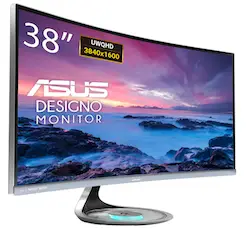
First up is the ASUS Designo Curve Monitor at 37.5 inches in size and 21:9 aspect ratio. It’s an Ultra-Wide Quad High Definition (UWQHD) (3840 x 1600) monitor will a crystal-clear curved screen. Its curvature gives it a 178° viewing angle allowing you to work from virtually anywhere on your desk. It comes with 1 DisplayPort 1.2, 2 HDMI 2.0 ports and a USB Type-C port.
Looking at the ASUS Designo is a wonder thanks to the frameless design and transparent sundial base. The edges of this monitor have very little bezel with the ports facing downwards from the bottom of the monitor for a seamless look. The sundial base has a 15W Qi wireless charging pad with a status-monitoring light.
This monitor comes with ear-pleasing stereo 10W Harman Kardon speakers. These are further tuned to the signature ASUS SonicMaster technology for rich and spacious sound. You won’t need your external speakers with this one.
Your eyes won’t strain when using this monitor thanks to the ASUS Eye Care technology which has TUV Rhineland-certified flicker-free backlighting with a blue light filter that minimizes eye fatigue. Blue light has been known to negatively affect sleep and the filter prevents that.
Pros
- 37.5 inches large.
- 21:9 aspect ratio.
- 178° viewing angles.
- 1 DisplayPort 1.2, 2 HDMI 2.0 ports and a USB Type-C port.
- Very thin bezels with ports facing downwards.
- 5-way navigation key.
- Transparent sundial base with wireless 15W Qi charging pad with monitoring lighting.
- Stereo 10W Harman Kardon speakers with ASUS SonicMaster technology for great sound.
- ASUS Eye Care technology with blue light filter to protect the eyes.
Cons
- The build quality isn’t the best.
For a quality reading monitor with built in speakers, great pictures and videos and future-proof ports such as USB C, this one is the best.
2. Philips 276E8VJSB 27” Monitor, 4K UHD IPS
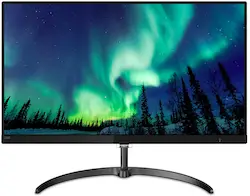
Next is the very impressive Philips 276E8VJSB 27-inch monitor. It’s a 4K UHD (3840 x 2160) resolution monitor with a 10-bit IPS panel producing up to 1.074 billion colors. The color accuracy on this monitor is out of this world to say the least.
The Multiview feature enables active dual connect and view at the same time. With the slim and elegant design comes flicker-free technology with low Blue mode to protect the eyes. You get a DisplayPort 1.2, 2 HDMI 2.0 ports and HDMI audio-out port.
Pros
- 27” screen size.
- 4K UHD (3840 x 2160) resolution.
- 10-bit IPS panel produces 1.074 billion colors for high color accuracy.
- Narrow border display with an elegant design.
- Multiview allows for active dual connections and viewing at the same time.
- DisplayPort 1.2, 2 HDMI 2.0 ports and HDMI audio-out ports.
- Flicker-free technology with low Blue mode for eye protection.
- 4-year advance replacement warranty in the United States.
- EnergyStar 7.0 certified with 100% recyclable materials.
Cons
- Few ports.
This monitor has one of the most color-accurate screens on any monitor on the market. Other than having one or two ports less than the competition, it’s a great monitor for your reading and office work in general.
3. BenQ 24 Inch IPS Monitor
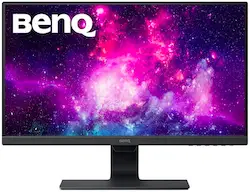
BenQ packed some great technologies in this full HD 1080p IPS panel monitor. It’s a 23.8-inch full HD IPS screen with a 1920×1080 resolution, 250 nits of brightness and built-in speakers. For a flat panel, it has an impressive 178° wide viewing angle which is really impressive.
The ultra-slim bezels and small base make it stable and elegant on your work desk. The monitor also comes with brightness adaptive technology, low blue light and zero-flicker to protect your eyes. The cables are neatly hidden in the base for a clean desktop experience.
Pros
- 24-inch screen size.
- Full HD IPS widescreen with 1920×1080 resolution.
- 250 nits of brightness.
- Built-in speakers.
- Ultra-slim bezels with an elegant design.
- Multi-panel configurations for extended viewing.
- Eye-care features such automatic brightness adjustment, low blue light and zero-flickering.
- Easy cable management as cables go into the stand.
- VESA wall mount (100 x 100 mm).
- 60Hz refresh rate.
Cons
- Some customers complain of less than optimal customer support.
For a small to medium-sized monitor for reading and other office tasks, BenQ scored a home run with this one.
4. Dasung E-Ink Paper Like 3 HD 13.3” Monitor
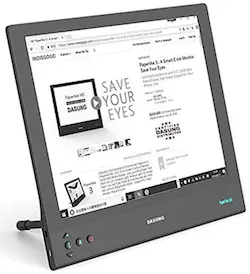
If you like the feel of paper and want that for your work, nothing beats the Dasung E-Ink Paper Like HD monitor. It has an E-ink display at HD retina resolution of 2200×1650. Even when it’s an E-ink, it’s very responsive and works in both vertical and horizontal orientations. You can enjoy long hours of reading, research on the web and coding on this monitor without straining the eyes.
You don’t need any complex setups as the monitor is powered by a USB cable and fed with an HDMI cable. It works with most sources including Windows, Mac, Linux, iPad, iPhone and others. Without light being emitted from the monitor, you’ll have a great paper-like monitor as a secondary screen.
Pros
- Paper-like E-Ink 13.3” screen reduces eye strain and uses very little power.
- Easy setup with USB and HDMI ports only.
- No glare means you can use it outdoors without straining.
- 4 display modes for dynamic viewing.
- Works in vertical and horizontal positions.
Cons
- None.
A must-have as a secondary screen for coding and reading documents. It does a great job at displaying items just like on paper even when you can interact with it.
5. Acer CB242Y bir 23.8” Full HD
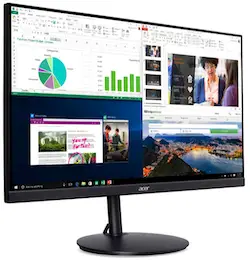
The Acer CB242Y bir has a full HD (1920×1080) resolution screen at 23.4 inches size. It comes with an impressive 75HZ refresh rate which makes scrolling smooth and seamless. The AMD RADEON FreeSync feature means that you won’t experience any stuttering and tearing of images when watching videos.
It has a Zero Frame Design with very thin bezels for a clean and elegant look on your desk. The ErgoStand is a small circular puck which keeps the desktop clean and seamless. You get a HDMI 1 and a VGA port with VGA cable included.
Pros
- 23.8-inch screen size.
- Full HD (1920×1080) resolution.
- 75 Hz refresh rate with HDMI port.
- HDMI 1 and VGA ports.
- Zero Frame Design with ErgoStand make for an elegant design.
- BlueLightShield, ComfyView, Low Dimming and Flickerless technologies protect the eyes.
- Adjustable in height, angle and other aspects.
Cons
- Not the best for videos.
You’ll thank yourself for getting this monitor as it provides among the best reading and coding experiences.
6. ViewSonic VX3276-MHD 32 Inch Frameless Widescreen IPS Monitor
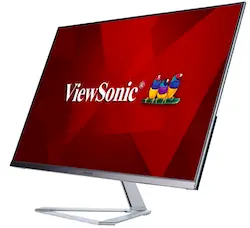
At 32 inches, the ViewSonic VX3276-MHD monitor is slightly on the larger side for reading but its great features make it a must-have if you’re in the market for a quality monitor with full HD and the proven IPS technology. To say the least, it looks great thanks to its thin bezels and elegant base.
It has a flicker-free screen with blue light filter which keeps the eyes happy even when used for the whole day. It comes with ViewSplit technology which makes it possible to split the screen into two windows both active at the same time.
Pros
- Full HD 1920×1080 resolution.
- Thin frameless bezel for a clean beautiful outlook.
- Wide viewing angles (178°).
- Flicker-free technology with blue light filter protect the eyes.
- ViewSplit technology allows for dual active windows from different feeds.
- Ports: VGA, DisplayPort and HDMI.
- Dual integrated speakers.
Cons
- Not great for videos.
This monitor is so tuned to office work such as document reading and processing that it somehow doesn’t provide the best video viewing. However, for a monitor for reading, coding or other text processing procedures, it’s one of the best.
7. BenQ 24 Inch 1080p Monitor GL2480
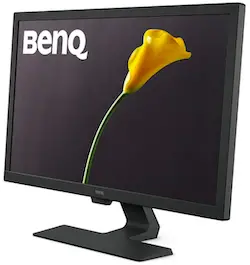
Wrapping up this list is the awesome BenQ GL2480 monitor with 24 inches of screen size. It’s a full HD monitor with a 1ms response time that translates to lightning fast response to changes such as scrolling the content of your screen. It comes with Low Blue Light and ZeroFlicker technologies to protect your eyes. It comes with an HDMI port to connect computers and to act as a secondary display.
Pros
- Low Blue Light and ZeroFlicker technologies protect the eyes.
- 24 inches screen size.
- Full HD 1080 resolution.
- 1ms response time for non-lagging performance.
- Good design with 16:9 aspect ratio.
Cons
- Doesn’t pack to many ports.
This is a monitor for the user who needs something laid back to go through their work. It’s not fancy or advanced enough for the most graphic-intensive tasks but a great one still.
The monitors reviewed here fit different people with different needs. The one aspect keeping them together is that fact that they all do a great job when it comes to reading documents and other text-intensive tasks.
Buyers’ Guide: What to Look for When Choosing a Monitor for Reding Text
For the best reading monitor, you need to look out for the following aspects:
1. The monitor panel type
The type of monitor panel determines how good a monitor is with the main types being IPS (In-Plane Switching), TN (twisted nematic), VA (Vertical Alignment), OLED (Organic Light-Emitting Diode), and E-Ink (Electronic Ink) panels.
The best of this lot is the OLED one although it comes at a steeper cost compared to the rest. The E Ink ones are the best for reading although they’re not suited to other tasks as they’re mostly reliant on ambient lighting and display mostly black and white colors only.
The most common one is IPS as it has a good balance between the color and other features on one hand, and price on the other. It’s found in a majority of the monitors on the market as noted in our review.
2. Screen resolution
I’m technical terms, the screen resolution refers to the number of pixels in a screen both on the horizontal and vertical axes. Normally, there are 1920 and 1080 on the axes respectively. In simple terms, it refers to how sharp the screen is or can be.
For most people doing reading work, a 1080p resolution (HD) is enough o render clear and crisp images and text that won’t strain the eyes. Also, a monitor with HD resolution keeps the costs down as compared to 4K for example.
If you need better resolution, go for more pixels for your monitor all the way up to 8K.
3. Screen size and aspect ratio
With screen sizes, the general assumption is that the bigger it is, the better it will be. However, the fact that you’ll be siting close to the monitor means that you don’t need a giant screen on your desk. As such, you just need a screen between 20 and 40 inches (diagonal distance).
As for the aspect ratio, it refers to how wide a screen is with the standard being 16:9. You can go for a slightly wider one at 21:9 or an ultrawide one at 32:9 or more. A wide screen allows for viewing more horizontal content although only useful in some incidences and not others.
4. Screen brightness
The screen brightness is measured in candela per square meter (cd/m2) or nits. The brighter a screen is, the better since it can be used in bright light without straining your eyes. If it’s too bright, you can always dial it down to the level you’re comfortable with. We recommend going for a monitor with a top brightness of at least 250 nits.
5. Response Time
Response time for a monitor refers to how fast it can switch between colors. It’s measured in milliseconds with most screens rated between 1 to 10 milliseconds (ms). Put simply, the lower the response time, the better the images and even videos will be. For the best experience, go for the maximum of 1ms response time.
6. Refresh rate
The refresh rate is a measure of how many times the screen updates the contents per second. The higher the refresh rate, the better. Most monitors are rated at 60 Hz meaning they refresh the content 60 times a second which is enough for reading. For graphic-intensive work, go for higher refresh rates from 75 Hz all the way to 240 Hz and beyond.
7. Eye care features
Monitors that make it easy to take care of your eyes have some the following features:
- Non-flickering screen: also called flicker-free screens, these provide a steady light that’s gentle to the eyes.
- Anti-glare capabilities: these reduce the amount of light reflected back to your eyes when using the screen. This eliminates bright and dark or blurred spots on the screen. The glossier a screen is, the more glare it’ll have. Matte finishes are the best for dealing with glare on the screen.
- Blue light filter: blue light negatively affects sleep by suppressing the protein (melatonin) which. A blue light filter will often make the screen appear yellowish to the eyes.
- Reader mode: a reader mode often starts most of the other features on this list and can even hide other parts of the document leaving only the text and graphics for your viewing.
- Adjustable/ergonomic stand: an adjustable stand allows you to change the height, angle and other features of the monitor for the perfect viewing angle for your eyes and neck.
A monitor should at least have a non-flickering screen and with a blue light filter to warrant buying it.
8. Speakers
While you can always connect external speakers to your monitor, having speakers bundled into the monitor is a good addition. Most speakers will have enough sound quality when in use since you’ll be close to them.
9. Connectivity
Connectivity, in this case, refers to how many different ports the monitor has and to how many inputs it can be connected. The basic ones are HDMI and VGA although others such as DisplayPort and audio in/out are important. With lots of things going towards USB Type C, it’s good having such a port as it’ll soon be the only port and cable you’ll need.
10. Price and warranties
As with everything, the higher the specs, the more you’ll pay. With reading monitors, you don’t need to spend so much since you won’t be needing the top-end specs like someone who does graphic-intensive work or who consumes lots of video and gaming content.
A long warranty should be the priority since it gives you the peace of mind of knowing that you’re issues will be fixed if you ran into some along the way. However, this shouldn’t be a deal breaker unless the warranty is completely omitted.
11. Other features
Some features which may or may not be important to you include support for dual inputs and dual views, wireless charging, portability and others. If a feature is vital to you, always make it a priority since it can make your life quite easy.
With these aspects in mind, choosing the best reading monitor for your work will be much easier. You should remember that reading monitors are the best when it comes to all tasks relaying heavily on text processing such as coding, research, writing and others.
